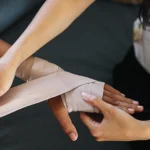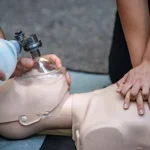
- Last Updated On: September 18, 2024
Essential Facts About Cardiopulmonary Resuscitation (CPR)
Cardiopulmonary Resuscitation (CPR) is a life-saving technique used when someone’s breathing or heartbeat has stopped. This technique is critical for people who suffer from sudden cardiac arrest or choking emergencies. Learning CPR can make a significant difference in critical situations, potentially saving lives and providing valuable help before professional medical services arrive.
Whether you’re dealing with an adult, child, or infant, the basic principles of CPR remain the same, though the techniques vary slightly. Knowing these CPR facts can boost your confidence and prepare you to respond effectively in any emergency. Taking a CPR course gives you the skills and confidence to act quickly in emergencies.
Importance of CPR
Knowing CPR is incredibly important because it can potentially save a life in emergencies. Whether you’re at home, at work, or out in public, being prepared to act quickly can be the best possible care during cardiac and respiratory crises. Here’s why learning CPR is essential:
- Immediate Response: CPR can be performed right away, providing critical help before professional medical teams arrive.
- Increases Survival Rates: Timely CPR can significantly improve the chances of survival upto 50-70% for someone experiencing cardiac arrest.
- Maintains Blood Flow: Chest compressions keep blood flowing to vital organs, which can prevent brain damage and other severe outcomes.
- Simple Technique: CPR is easy to learn and can be performed by anyone, making it a valuable skill for everyone.
- Boosts Confidence: Knowing CPR gives you the confidence to act calmly and effectively in emergencies, potentially saving a life.
Common CPR Facts
CPR consists of chest compressions and rescue breaths to maintain blood circulation and oxygenation. Knowing the basics of CPR will enable any bystander to become a lifesaver before professional help arrives. Here are some key points to know:
- CPR is Effective: One of the key facts about CPR is that immediate action can double or even triple a person’s chance of survival.
- Every Second Counts: The sooner CPR is started, the better the chances of survival. Immediate action can make a big difference.
- Hands-Only CPR: For adults, if you’re not trained in giving rescue breaths, performing chest compressions alone is still very effective.
- CPR is for All Ages: With some adjustments in technique, CPR can be used by people of all ages, including children and infants.
- CPR Can Be Learned Quickly: Many CPR courses are short and teach you all you need to know in just a few hours.
CPR Myths for Adults
As people are becoming aware of the CPR technique, more and more myths tend to float around in the general public. Therefore, knowing the right CPR facts and myths helps you understand when and how to apply this life-saving technique without a second thought.
- Myth 1: CPR is only needed in heart attacks.
Fact: CPR is not just for heart attacks. It’s essential for situations where someone’s breathing or heartbeat has stopped, including sudden cardiac arrest, choking emergencies, drowning, or severe trauma. In these cases, CPR helps keep blood flowing and provides oxygen until professional help arrives.
- Myth 2: You can do more harm than good with CPR.
Fact: While performing CPR can be intense, it is generally safe and crucial. The risk of causing harm is minimal compared to the potential benefit. Studies show that even if CPR is performed incorrectly, it still increases the chance of survival compared to doing nothing. Training helps ensure that you can perform CPR effectively and safely.
- Myth 3: CPR certification is not necessary if you’re not a healthcare professional.
Fact: CPR certification is valuable for everyone, not just healthcare professionals. Cardiac emergencies strike without warning, and in such situations, every minute counts. Basic training in CPR, which is readily available, teaches proper chest compression techniques and rescue breathing. While certification is not legally required for the general public, it ensures that you learn about up-to-date techniques which could make a lifesaving difference until professional help arrives.
- Myth 4: You only need to do CPR if the person is unconscious.
Fact: CPR is needed when a person is unresponsive and not breathing normally. Sometimes, a person might be semi-conscious or responsive but not breathing properly, and in such cases, CPR is still required. Hands-only CPR is effective, despite the CPR myths that say rescue breaths are always necessary.
- Myth 5: You should check for a pulse before starting CPR.
Fact: In real-life emergencies, it’s often difficult to feel a pulse. For this reason, if someone is unresponsive and not breathing normally, you should start CPR immediately without spending time checking for a pulse.
- Myth 6: You need to be strong to perform CPR effectively.
Fact: You don’t need to be particularly strong to perform CPR. Proper technique and rhythm are more important than physical strength. People of all sizes and strengths can perform effective chest compressions.
- Myth 7: If you start CPR, you have to continue until help arrives.
Fact: You should perform CPR as long as you are able and until professional help arrives or the person shows signs of recovery. If you are too exhausted or need to switch with another rescuer, it’s okay to take turns.
- Myth 8: You should avoid giving CPR if you’re unsure about the situation.
Fact: If you’re unsure whether someone needs CPR, it’s better to start CPR if the person is unresponsive and not breathing normally. Most trained responders would rather have someone start CPR and potentially be mistaken than miss an opportunity to save a life.
CPR Myths for Infants and Toddlers
CPR for babies and toddlers requires a different approach than CPR for adults, and several myths can confuse caregivers or parents. Knowing the truth behind these myths can give you the confidence to act if a young child’s life is at risk. Here are some common myths about CPR for babies and toddlers:
- Myth 1: Infants and toddlers don’t need CPR since they’re too young to have heart problems.
Fact: While heart attacks in young children are rare, they can stop breathing or suffer cardiac arrest due to choking, drowning, or severe illness. Thus, CPR is just as important for babies and toddlers in emergencies like these as it is for adults.
- Myth 2: You should perform CPR on babies the same way you would on adults.
Fact: Babies and toddlers require gentler techniques. For infants under one year, responders use two fingers for chest compressions instead of the whole hand. Compressions should be more shallow, and breaths should be given more gently due to their smaller, more delicate airways.
- Myth 3: Mouth-to-mouth resuscitation isn’t necessary for infants.
Fact: Rescue breaths are a crucial part of CPR for infants and toddlers. Since infants are more likely to suffer breathing problems, combining rescue breaths with chest compressions is essential to getting oxygen to their lungs and brain.
- Myth 4: You’ll hurt a baby if you perform CPR.
Fact: Although it’s natural to worry about causing harm, doing nothing is far riskier. Gentle chest compressions and rescue breaths can save a baby’s life, and any potential injury is less critical than the risk of not providing life-saving help.
- Myth 5: Only healthcare professionals should perform CPR on babies and toddlers.
Fact: Anyone trained in CPR can and should perform it on infants in an emergency. As far as emergencies are concerned, immediate action by parents, caregivers, and passersby is very critical. While the techniques for infant CPR differ slightly from those of adults, early intervention always makes all the difference in survival rates before the arrival of medical help. Training in CPR is advised to be taken on a routine basis.
- Myth 6: If the baby starts coughing or crying, you should stop CPR immediately.
Fact: If the baby shows signs of life, such as coughing or crying, you should stop chest compressions but still monitor their breathing. If they stop breathing again, resume CPR. A child coughing or crying is a good sign, but you should remain alert and ready to act.
- Myth 7: If you don’t see immediate results, CPR isn’t working.
Fact: CPR helps keep oxygen flowing to the brain and organs even if you don’t see immediate signs of recovery. It can take several minutes for the child to respond or for emergency services to arrive. Keep going until help arrives, or the baby starts breathing again.
How to Choose the Best CPR Course
Choosing the right CPR course is an important step. Whether you’re learning for personal reasons or your job. With so many options available, it’s essential to find one that fits your goals. Here’s a guide to help you make the best choice:
- Check Accreditation: Ensure a recognized organization accredits the course. This ensures the training meets industry standards.
- Instructor Experience: Look for a course led by experienced instructors. They should have both practical knowledge and teaching skills to guide you effectively.
- Course Format: Some courses are offered in person, online, or as a mix of both. Choose a format that suits your learning style and schedule.
- Hands-on Training: Make sure the course includes hands-on practice with CPR mannequins. This will allow you to apply what you’ve learned and build confidence.
- Certification Validity: Check the certification’s validity. Most CPR certifications are valid for two years, so you’ll need to renew them after that period.
- Course Focus: Some courses focus on basic CPR, while others include more advanced topics like AED use or first aid. Choose a course that matches your level of need.
- Cost: Compare prices between courses, but remember that the cheapest option isn’t always the best. Balance cost with the quality of training.
Wrapping Up
CPR is not just for healthcare professionals; it’s a skill that anyone can learn and apply in emergencies. Therefore, understanding key CPR facts is essential when choosing the best course to suit your needs. Regular practice and staying updated on CPR guidelines will keep you prepared to act confidently when needed. The right course will give you the confidence and skills to act quickly and effectively.
Read More:




